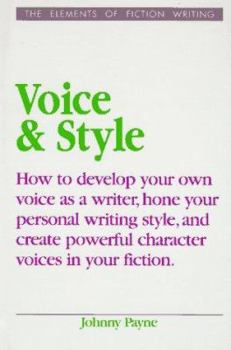Book Overview
No Synopsis Available.
Format:Hardcover
Language:English
ISBN:0898796938
ISBN13:9780898796933
Release Date:January 1995
Publisher:Writer's Digest Books
Length:176 Pages
Weight:0.95 lbs.
Dimensions:0.8" x 6.3" x 9.3"
Customer Reviews
3 ratings
A wonderful book
Published by Thriftbooks.com User , 25 years ago
Johnny Payne's book is a wonderful creative writing tool for both teaching and learning on your own, complete with indepth analysis--all presented in a very accessible style. (Although I could have done without the personal stories about the wife, etc.) Use this book and follow the exercises, and your writing will improve.
Dr. Johnny Payne's Text succeeds where others have failed
Published by Thriftbooks.com User , 25 years ago
Dr. Johnny Payne's text VOICE AND STYLE is an excellent tool for helping fiction writers develop their own individual creative voice. Payne accomplishes this by taking the larger term known as "Style" and breaking it down into identifiable and practicable elements. These elements include but are not limited to Habits of Speech, Authority and Voice, Atmosphere and Tone, and Voice in Dialogue. His approach is analytical and thought-provoking but never boring. Using this "nuts and bolts" approach, he walks the reader through each subject using personal anecdotes and examples of his own creative process. Payne also draws on the wisdom and varied styles of many modern and time-proven authors from Barthelme and Cisneros through James, Hemingway, and Fitzgerald. Dr. Payne believes that the techniques of fiction writing can be taught and he includes creative excercises at the end of each chapter that are designed to allow the practicing writer to apply specific elements to her or his own personal writing style. In a sense, Dr. Payne's text teaches writers by allowing them to discover and improve on what they already know. In the end, the student feels led along the creative path rather than pushed down it. The result is a highly effective and entertaining text that most writing students will want to keep and refer back to often.
I give Payne an A+
Published by Thriftbooks.com User , 25 years ago
In "Voice and Style," Payne shows how to use the dramatic voice in dialogue to make the story more interesting by adding emotion. I loved his use of the Wizard of Oz example with "Dorothy from Kansas" to show how you " . . . don't have to look any further than your own backyard for a diphtong" with even the Wizard "after trying his hand and failing at Emerald- speak, turns out to be `an old Kansas man . . .'" himself. Though the reader will learn that Payne is from Kentucky and his wife (who claims she does not have an accent) is from Indiana, they spent years in Chicago while he taught at Northwestern University, which is what likely gave their young daughter a Chicago accent. He writes: "Above all, you have to cultivate an ear for the dialect of your own kind . . . [without] lay[ing] it on too thick." Payne also shows how to use the "right words in the right place" among various people in the story's community to create memorable characters. He discusses the authorial voice, which is how the author makes the story meaningful through defining the subject and message of the story. Payne explains how the "objects of thought must be set in motion, and voice provides that motion." Payne offers excellent examples, such as: Fitzgerald's, The Great Gatsby, with the neighbor Nick Carroway as narrator, and Nabokov's Lolita, with the step father/pedophile lover, Humbert Humbert as narrator. Finally, the last section of Payne's book shows how to allow the "various voices to operate as one." I give him an A+.





